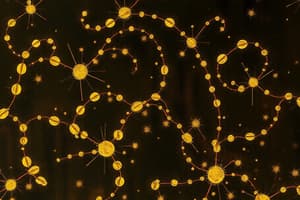Podcast
Questions and Answers
What is electronegativity and how is it measured?
What is electronegativity and how is it measured?
Electronegativity is the tendency of an element to attract a pair of electrons, measured using the Pauling scale.
Describe the conditions under which a covalent bond will typically form.
Describe the conditions under which a covalent bond will typically form.
A covalent bond forms when the energy of the bonded atoms is lower than that of the separate atoms.
What is the significance of electronegativity differences in bond formation?
What is the significance of electronegativity differences in bond formation?
Electronegativity differences determine the type of bond formed: nonpolar covalent, polar covalent, or ionic.
What characteristics define nonpolar covalent bonds?
What characteristics define nonpolar covalent bonds?
Signup and view all the answers
How does the difference in electronegativity quantify polar covalent bonds?
How does the difference in electronegativity quantify polar covalent bonds?
Signup and view all the answers
Explain the bonding characteristics of chlorine molecules.
Explain the bonding characteristics of chlorine molecules.
Signup and view all the answers
How do single, double, and triple bonds differ?
How do single, double, and triple bonds differ?
Signup and view all the answers
Describe the characteristics of hydrogen bonding.
Describe the characteristics of hydrogen bonding.
Signup and view all the answers
What is meant by a delta positive (δ+) charge in a molecule?
What is meant by a delta positive (δ+) charge in a molecule?
Signup and view all the answers
How does the difference in electronegativity relate to the type of bond formed between elements?
How does the difference in electronegativity relate to the type of bond formed between elements?
Signup and view all the answers
Identify the typical characteristics of ionic compounds.
Identify the typical characteristics of ionic compounds.
Signup and view all the answers
What does a delta negative (δ-) charge signify in a chemical context?
What does a delta negative (δ-) charge signify in a chemical context?
Signup and view all the answers
Explain the factors that determine the bond type between two nonmetals.
Explain the factors that determine the bond type between two nonmetals.
Signup and view all the answers
What is the significance of the values 2.20, 3.44, and 3.16 in electronegativity?
What is the significance of the values 2.20, 3.44, and 3.16 in electronegativity?
Signup and view all the answers
Why do ionic compounds generally form between elements on opposite sides of the periodic table?
Why do ionic compounds generally form between elements on opposite sides of the periodic table?
Signup and view all the answers
In the context of bonding, how do lone pairs affect molecular polarity?
In the context of bonding, how do lone pairs affect molecular polarity?
Signup and view all the answers
Describe the concept of partial charges in molecules.
Describe the concept of partial charges in molecules.
Signup and view all the answers
What distinguishes a covalent bond from an ionic bond in terms of electron transfer?
What distinguishes a covalent bond from an ionic bond in terms of electron transfer?
Signup and view all the answers
Explain how the direction and length of a vector represent bond polarity.
Explain how the direction and length of a vector represent bond polarity.
Signup and view all the answers
What role does the parallelogram method play in determining molecular polarity?
What role does the parallelogram method play in determining molecular polarity?
Signup and view all the answers
How can the molecular structure of C2H2Cl2 result in both polar and non-polar configurations?
How can the molecular structure of C2H2Cl2 result in both polar and non-polar configurations?
Signup and view all the answers
What does a net dipole moment of zero indicate about a molecule's polarity?
What does a net dipole moment of zero indicate about a molecule's polarity?
Signup and view all the answers
Describe how the electronegativity values aid in determining the polarity of bonds.
Describe how the electronegativity values aid in determining the polarity of bonds.
Signup and view all the answers
Describe how the polarising power of cations changes across a period.
Describe how the polarising power of cations changes across a period.
Signup and view all the answers
Explain the trend of anion size and polarisability as you move down a group.
Explain the trend of anion size and polarisability as you move down a group.
Signup and view all the answers
How does the polarising power of cations compare among diagonal neighbours like Li+ and Mg2+?
How does the polarising power of cations compare among diagonal neighbours like Li+ and Mg2+?
Signup and view all the answers
What is the significance of the difference in polarisation between NaCl and MgCl2?
What is the significance of the difference in polarisation between NaCl and MgCl2?
Signup and view all the answers
Define what an electric dipole is in the context of ionic compounds.
Define what an electric dipole is in the context of ionic compounds.
Signup and view all the answers
How do partial charges arise in ionic compounds?
How do partial charges arise in ionic compounds?
Signup and view all the answers
Why do cations become larger and less polarising when moving down a group?
Why do cations become larger and less polarising when moving down a group?
Signup and view all the answers
What role does electronegativity play in determining the polarisation in ionic bonds?
What role does electronegativity play in determining the polarisation in ionic bonds?
Signup and view all the answers
Discuss the relationship between the charge of a cation and its polarising ability.
Discuss the relationship between the charge of a cation and its polarising ability.
Signup and view all the answers
Summarize the trend in polarisability of anions as one moves across a period.
Summarize the trend in polarisability of anions as one moves across a period.
Signup and view all the answers
What is the difference between a polar bond and a polar molecule?
What is the difference between a polar bond and a polar molecule?
Signup and view all the answers
How can a molecule with multiple polar bonds be nonpolar?
How can a molecule with multiple polar bonds be nonpolar?
Signup and view all the answers
What does the dipole moment (μ) indicate about a molecule?
What does the dipole moment (μ) indicate about a molecule?
Signup and view all the answers
Why does CO2 have a dipole moment of 0 despite having polar bonds?
Why does CO2 have a dipole moment of 0 despite having polar bonds?
Signup and view all the answers
How does molecular shape influence the polarity of dichloromethane (CH2Cl2)?
How does molecular shape influence the polarity of dichloromethane (CH2Cl2)?
Signup and view all the answers
In the context of molecular polarity, what role do vectors play?
In the context of molecular polarity, what role do vectors play?
Signup and view all the answers
What is the dipole moment (μ) of NaCl, and why is it significant?
What is the dipole moment (μ) of NaCl, and why is it significant?
Signup and view all the answers
Identify a nonpolar molecule from the provided list and explain why it is nonpolar.
Identify a nonpolar molecule from the provided list and explain why it is nonpolar.
Signup and view all the answers
What can be inferred about the polarity of BF3 based on its dipole moment?
What can be inferred about the polarity of BF3 based on its dipole moment?
Signup and view all the answers
Study Notes
Electronegativity
- A measure of an element's tendency to attract electrons in a chemical bond.
- The Pauling scale is used to quantify electronegativity.
Bonding
- Chemical bonds form when the energy of bonded atoms is lower than that of separate atoms.
- Atoms strive for stable electron configurations, typically by filling their outermost electron shells.
- Electronegativity influences bond types.
- Bond types include:
- Nonpolar covalent
- Polar covalent
- Ionic
- Hydrogen bonding
- Coordinate bonds
- Metallic bonds
- Single, double, triple bonds
- σ-bonds
- π-bonds
Nonpolar Covalent Bonds
- Atoms share electrons equally, resulting in no or tiny partial charges on atoms.
- Form molecular compounds.
- Exist as solids, liquids, or gases at normal temperatures and pressures.
- Typically formed between elements with similar electronegativities.
- Electronegativity difference < 0.5
Polar Covalent Bonds
- Electrons are shared unequally between atoms, creating partial charges (δ+ and δ-).
- Form molecular compounds.
- Exist as solids, liquids, or gases at normal temperatures and pressures.
- Electronegativity difference > 0.5, < 2.0
Ionic Bonds
- Complete transfer of electrons from one atom to another, resulting in fully charged ions.
- Electronegativity difference > 2.0
- Form ionic compounds.
- Generally exist as solids at normal temperatures and pressures.
- High aqueous solubility is common.
Polarisation
- Cations can distort the electron cloud of an anion, leading to polarization:
- Smaller, more highly charged cations are more polarizing.
- Cations become less polarizing down a group in the periodic table.
- Diagonal neighbors in the periodic table have similar polarizing power.
- Anions also experience polarizability:
- Smaller, less charged anions are less polarizable.
- Anions become more polarizable with more positively charged cations.
- Anions become more polarizable down a group in the periodic table.
Dipoles and Partial Charges
- Partial charges are slight shifts in electron distribution.
- Electric dipole: A positive charge next to an equal but opposite negative charge.
- Electric dipole moment (μ): Measures the magnitude of a dipole, expressed in debyes.
Polar Bonds vs. Polar Molecules
- Polar bond: A covalent bond between atoms with partial electric charges.
- Polar molecule: A molecule with a non-zero electric dipole moment.
- A molecule can have polar bonds but be nonpolar overall if the bond dipoles cancel each other due to molecular shape.
Testing Molecular Polarity using Vectors
- Vectors can be used to determine the net polarity of molecules.
- A vector can represent a polar bond, with direction pointing towards the more polar atom and length representing bond polarity.
- Vectors can be added and subtracted to calculate the overall dipole moment of a molecule.
- If the vectors sum to zero, the molecule is nonpolar. If the vectors sum to a non-zero value, the molecule is polar.
Studying That Suits You
Use AI to generate personalized quizzes and flashcards to suit your learning preferences.
Related Documents
Description
Explore the concepts of electronegativity and the various types of chemical bonds in this quiz. Understand how electronegativity influences nonpolar and polar covalent bonds, as well as ionic and other types of bonding. Test your knowledge on these essential chemistry principles.




